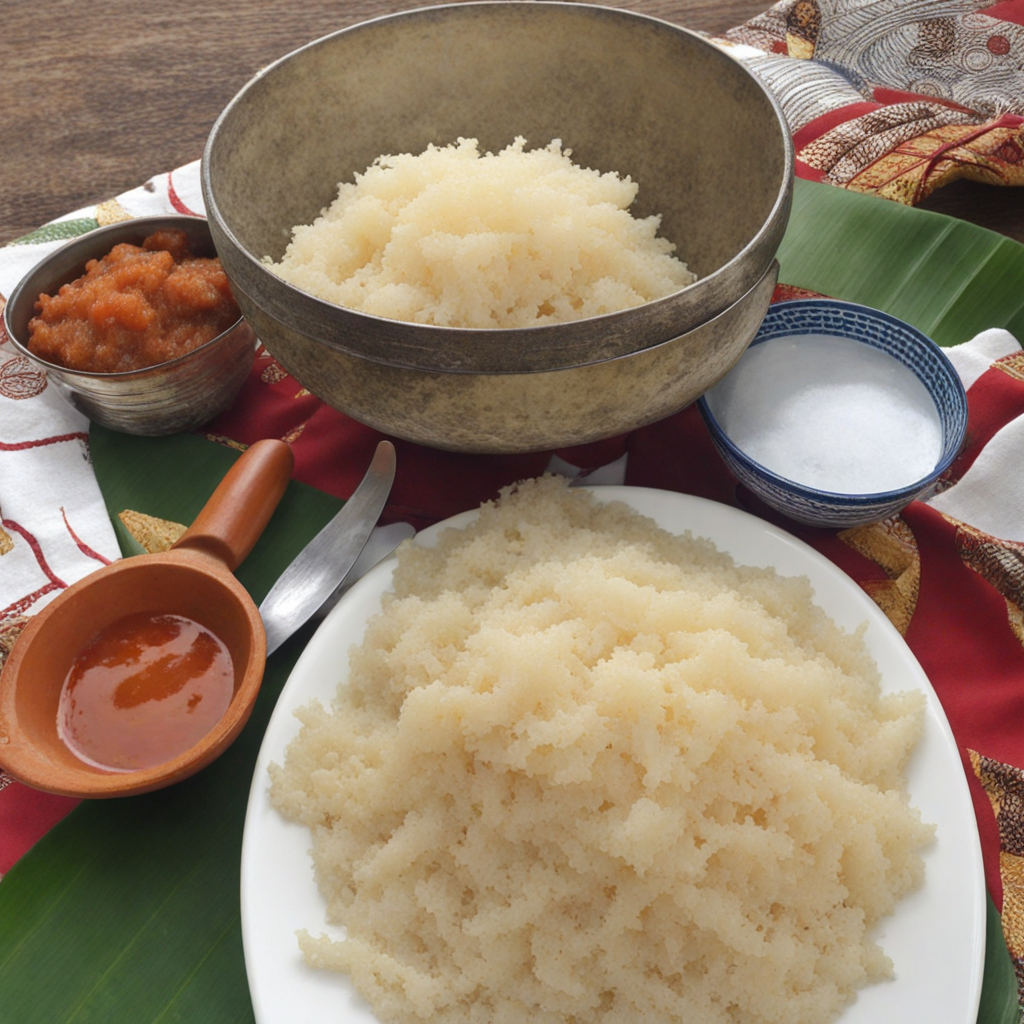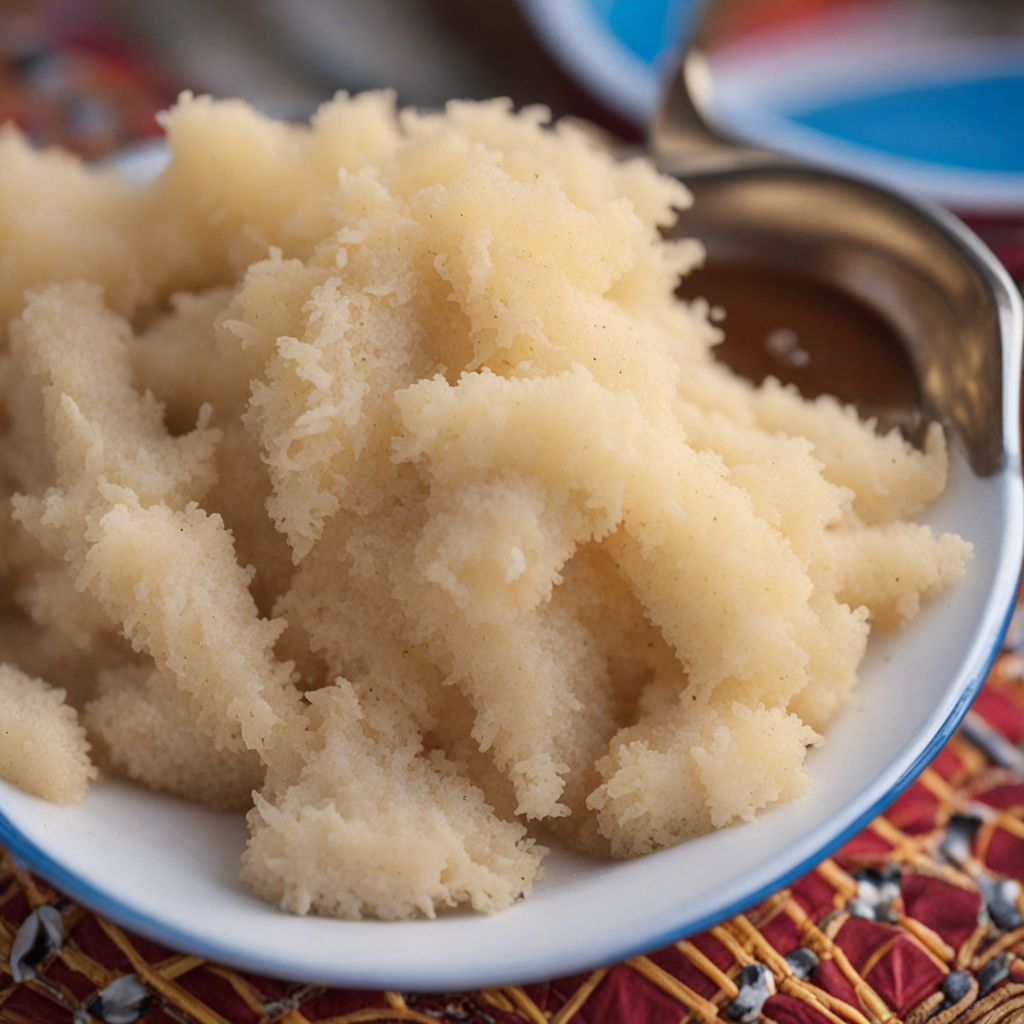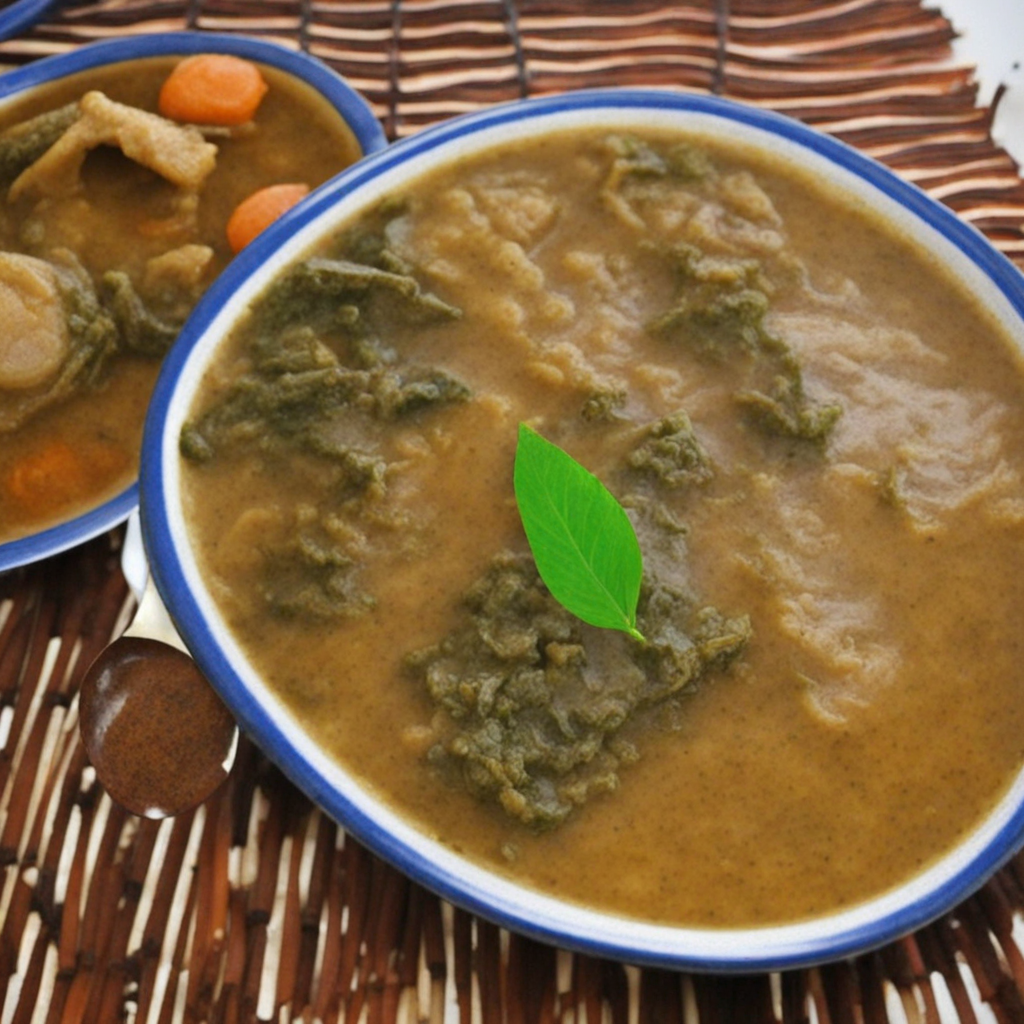Gari
Gari is a unique and versatile food staple from Benin, made from fermented and processed cassava tubers. The process begins with peeling, grating, and fermenting the cassava, which enhances its flavor and texture. Once fermented, the cassava is dried and roasted, creating a fine, granular texture that resembles coarse flour. This delightful ingredient is not only gluten-free but also packed with carbohydrates, making it an excellent source of energy. Its mildly nutty flavor and slightly tangy undertones make it an exciting base for a variety of dishes. In Benin, Gari is often enjoyed in different forms, most popularly as a side dish or a main meal. One common way to serve Gari is by soaking it in cold water or milk, transforming it into a creamy, pudding-like consistency known as 'Gari soak.' This dish is often sweetened with sugar or honey and can be paired with fruits such as bananas or mangoes, creating a delightful contrast of flavors and textures. Alternatively, Gari can be used as a base for savory dishes, where it is combined with stews or soups, allowing it to absorb the rich flavors of the accompanying ingredients while maintaining its own unique taste. The versatility of Gari extends beyond just being a meal; it can also be used in snacks and desserts. In some regions, Gari is fried to create crunchy snacks that are perfect for on-the-go munching. Additionally, creative chefs have started incorporating Gari into modern recipes, such as Gari cakes or Gari pancakes, providing an innovative twist on traditional flavors. With its rich culinary heritage and adaptability, Gari offers a delightful taste experience that invites adventurous eaters to explore the diverse flavors of Benin.
How It Became This Dish
The History of Gari: A Staple Food from Benin #### Origins Gari, a versatile and popular food, has its roots deeply embedded in the agrarian history of West Africa, particularly in countries like Benin, Nigeria, and Togo. This staple food is made from cassava (Manihot esculenta), a tuber native to South America that was brought to Africa by Portuguese traders in the 16th century. The introduction of cassava marked a significant shift in agricultural practices; it thrived in the tropical climate of West Africa, which often presented challenges for traditional crops like yams and maize. The process of making gari involves peeling, grating, fermenting, and then frying the cassava in a dry pan until it reaches a desired texture and color. The result is a fine, granular product that can vary in color from white to yellow, depending on the preparation method and the variety of cassava used. Gari is not only a staple in Benin but also serves as a key ingredient in various dishes across West Africa, showcasing its adaptability and significance in the local diet. #### Cultural Significance In Benin, gari is more than just a food; it embodies cultural identity and communal values. It is often consumed during significant events, celebrations, and rituals, highlighting its role as a symbol of sustenance and togetherness. For many communities, the preparation and sharing of gari foster social cohesion. Families gather to prepare it, passing down traditional methods from one generation to the next. Gari is also integral to the local economy. It is a vital source of income for many farmers and processors, who rely on the cassava crop as a primary agricultural product. The production and sale of gari empower local communities, providing livelihoods and promoting food security. Beyond economic significance, gari holds a place in culinary tradition, featuring in various dishes such as "gari fort," a porridge-like meal, and "gari soak," where it is rehydrated and enjoyed with sugar, milk, or fruits. #### Development Over Time The journey of gari reflects broader changes in Benin's social, economic, and political landscape. During the colonial period, cassava and its derivatives, including gari, became crucial for sustaining local populations amidst disruptions caused by European exploitation. Gari's resilience as a food source during this turbulent time cemented its role in the diet of the people. As Benin transitioned into independence in 1960, the emphasis on local food production increased. Gari became a symbol of national pride, representing the ability to thrive on local resources. Efforts to promote agricultural self-sufficiency saw a rise in cassava cultivation, leading to greater production of gari. The government and various NGOs initiated programs to improve processing techniques, ensuring that gari could meet both local and international standards. In the 21st century, the increasing globalization of food systems has introduced challenges and opportunities for gari. With the rise of urbanization, there has been a growing demand for processed foods, which in some cases has led to a decline in traditional food practices. Nevertheless, gari has adapted to these changes. The emergence of modern processing facilities has enhanced production efficiency, allowing for greater distribution and access to urban markets. Moreover, innovations in marketing have fostered a renewed interest in traditional foods among younger generations, who are increasingly aware of the importance of cultural heritage and sustainable eating practices. The health benefits associated with cassava and gari have also gained recognition. Rich in carbohydrates, low in fat, and gluten-free, gari is a suitable option for many dietary needs. As the global food landscape shifts toward healthier eating, gari has captured the attention of health-conscious consumers both locally and abroad. #### Gari in Contemporary Cuisine Today, gari has transcended its status as a mere staple food. Chefs and home cooks alike have embraced it as a versatile ingredient in modern cuisine. Innovative dishes incorporating gari are increasingly common in restaurants and eateries across Benin and beyond. From gari-based snacks to gourmet meals, the food is being reimagined, showcasing its flexibility and potential. In addition to traditional uses, gari has found a place in fusion cuisines, where it is incorporated into various dishes, ranging from salads to desserts. This adaptability not only highlights the culinary creativity of chefs but also reinforces the notion that traditional foods can evolve while retaining their cultural essence. The increasing popularity of gari in international markets has led to its inclusion in diaspora communities, where it serves as a comforting reminder of home for many Beninese living abroad. #### The Future of Gari As we look toward the future, the story of gari is poised to continue evolving. The growing awareness of food sustainability and the importance of local sourcing present opportunities for gari to regain its status as a revered staple. Efforts to promote organic farming and sustainable agricultural practices are gaining momentum, ensuring that cassava cultivation remains viable while preserving the environment. Moreover, as global interest in African cuisine expands, there is potential for gari to become a celebrated ingredient in culinary scenes around the world. Food festivals, cooking shows, and culinary tours focusing on West African cuisine are beginning to highlight traditional foods like gari, introducing them to new audiences and palates. In conclusion, gari serves as a remarkable testament to the resilience and creativity of the Beninese people. Rooted in history and cultural significance, it has evolved alongside the society that cherishes it. As it continues to adapt to modern trends, the future of gari holds promise, not only as a staple food but as a symbol of heritage, community, and innovation.
You may like
Discover local flavors from Benin







